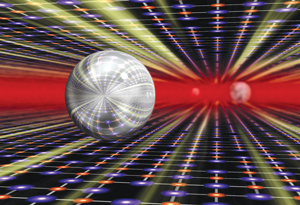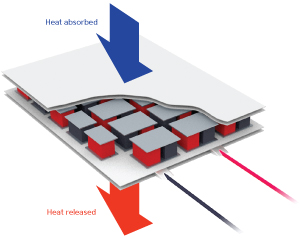Jul. 26, 2013 Research Highlight Chemistry Physics / Astronomy
Putting the heat on semimetals
A layered semimetal laced with atomic impurities offers highly efficient conversion between heat and electrical current
 Figure 1: Electrons in the layered semimetal CuAgSe can move particularly fast through the material. © 2013 Shintaro Ishiwata, RIKEN Center for Emergent Matter Science and The University of Tokyo
Figure 1: Electrons in the layered semimetal CuAgSe can move particularly fast through the material. © 2013 Shintaro Ishiwata, RIKEN Center for Emergent Matter Science and The University of Tokyo
In the early twentieth century, the very notion of a semiconductor—a material that behaves somewhere between an electrical conductor and insulator—was something even the leading physicists of the time thought improbable and unappealing. Yet we now find that semiconductors have become the bedrock of modern electronics. Semimetals are similarly unclassifiable as either metal or non-metal, and like the early days of semiconductors, their utility in electronics has so far been limited. Shintaro Ishiwata and colleagues from the RIKEN Center for Emergent Matter Science (CEMS), in collaboration with researchers from the University of Tokyo, have now found a layered semimetal compound that provides unprecedented efficiency of heat to electric current conversion at room temperature1, greatly expanding the possible applications of semimetals as thermoelectric materials.
From byproduct to main focus
 Figure 2: Peltier elements use an electric current to drive the transfer of heat from one side of the device to the other. © 2013 RIKEN Center for Emergent Matter Science and The University of Tokyo
Figure 2: Peltier elements use an electric current to drive the transfer of heat from one side of the device to the other. © 2013 RIKEN Center for Emergent Matter Science and The University of Tokyo
Ishiwata, previously from the CEMS and now with the University of Tokyo, had led a collaborative team in research on novel ‘spintronic’ devices—systems in which the magnetic properties of electrons are used rather than their electrical charge. Through those studies, the team discovered that a byproduct produced during their research, silver selenide (Ag2Se), displayed some interesting properties. The electrical resistance of the material was found to change remarkably depending on its interaction with magnetic fields. This effect, known as giant magnetoresistance (GMR), is used widely in modern electronic devices to read information from magnetic hard disk drives. Furthermore, the material also displayed high thermoelectric efficiency, generating a heat gradient when it passes an electrical current or generating an electrical current when cooled on one side and heated on the other. The combination of GMR and high thermoelectric efficiency is unusual, and the occurrence of GMR, in particular, shows that electrons can flow very easily through the material.
These behaviors had already been reported before for Ag2Se, but Ishiwata and his colleagues were spurred to look deeper. “We started studying related materials and found that one of them, CuAgSe, shows stronger GMR effects and better thermoelectric efficiency,” he says. CuAgSe is a multilayered semimetal consisting of alternating layers of silver (Ag) and copper selenide (CuSe) (Fig. 1).
Although Ishiwata notes that his research on CuAgSe began by “accident,” it turned out the material presented some exciting possibilities. The team’s work showed that the electrons in CuAgSe are particularly mobile, increasing its usefulness for device applications. More interesting, however, was the discovery that the electron mobility was increased when the material had been ‘doped’ with nickel atoms. Atomic impurities interrupt the regular atomic lattice of the host material and can be used to manipulate a material’s bulk electronic properties. Impurity doping, for example, is a conventional method used to control the conductive properties of semiconductors, and also the thermal and electrical conductive behavior of thermoelectric materials. However, the introduction of impurities generally has the unwelcome side effect of reducing the material’s electrical conductivity, thereby impairing its overall performance. Contrary to this typical behavior, Ishiwata’s team found that this is not the case in CuAgSe. “After the addition of nickel to CuAgSe, the electron mobility increased, even if we created a chemically ‘dirty’ system,” says Ishiwata.
By overcoming the traditional trade-off between ‘polluting’ the material in order to improve the thermoelectric performance and reduce electron mobility, the team has created a promising material that opens up the possibility of a range of interesting and new applications. One use of the technology the researchers have in mind involves applying the material as a Peltier cooling element (Fig. 2), in which electrical current is used to transfer heat from one side of the device to the other.
“So far, thermoelectric materials that work at low temperatures are limited to bismuth-based materials. Materials based on silver and copper are now promising candidates that offer better thermoelectric performance near or below room temperature,” says Ishiwata. The increase in electron mobility achieved by doping also enhances the GMR performance, although GMR in this material only appears at very low temperatures, making it less promising for practical applications.
The benefits of collaboration
Further work will now be done to optimize the thermoelectric performance of the CuAgSe material. “For this, we are planning to collaborate with specialists in transmission electron microscopy,” says Ishiwata. Electron microscopy observations will provide deeper insight into the structure of the material and especially how the impurities are organized. Collaboration, explains Ishiwata, has been a strong driving force throughout the project. Researchers with many different backgrounds come together at the CEMS and also within the collaboration between RIKEN and the University of Tokyo. “It is difficult to imagine that this project would have been successful elsewhere; the research groups cover such a broad range of condensed-matter science, and we have the opportunity to discuss ideas with each other frequently, which is essential for this kind of serendipitous work.”
Semiconductors, the very existence of which was doubted in the past, can claim full responsibility for making modern electronics possible. Advanced thermoelectric materials like CuAgSe also have a lot to offer: they achieve their useful functionality without movable parts, they are compact, and they already have the potential for use in the cooling elements of various electronic devices and consumer products such as portable coolers (Fig. 2). The discovery of high-performance thermoelectric materials, and in particular the demonstration of doping-enhanced electron mobility, provides a promising new platform for exploring and harnessing thermoelectric effects.
References
- 1. Ishiwata, S., Shiomi, Y., Lee, J. S., Bahramy, M. S., Suzuki, T., Uchida, M., Arita, R., Taguchi, Y. & Tokura, Y. Extremely high electron mobility in a phonon-glass semimetal. Nature Materials 12, 512–517 (2013). doi: 10.1038/NMAT3621
About the Researcher
Shintaro Ishiwata

Shintaro Ishiwata was born in Tokyo, Japan, in 1975. He graduated from Kyoto University in 1998 and obtained his PhD in 2003 from the same university. Following a year of postdoctoral research, Ishiwata moved to Waseda University as a JSPS research fellow and later became a visiting researcher at Princeton University in the United States. Upon returning to Japan, he worked on the ERATO–JST multiferroics project and then joined the Cross-Correlated Materials Research Group at RIKEN. In 2010, he moved to the University of Tokyo where he has been an associate professor since 2012. Ishiwata is also a visiting research fellow at the RIKEN Center for Emergent Matter Science. His research explores new materials that exhibit useful properties such as thermoelectricity, spintronics and superconductivity.
